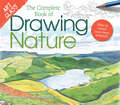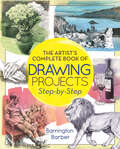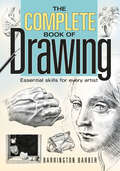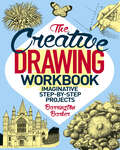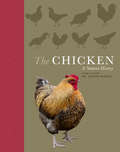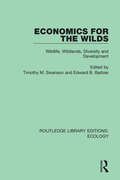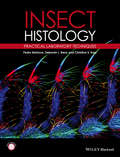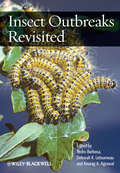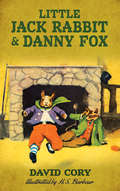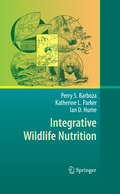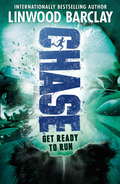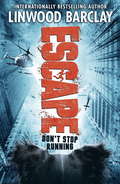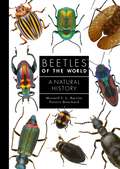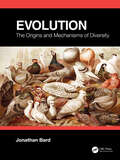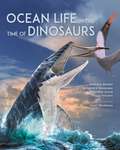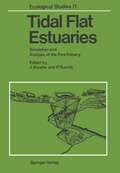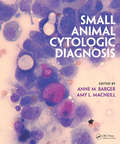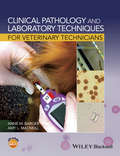- Table View
- List View
Art Class: How to Create Your Own Artwork (Art Class)
by Barrington BarberThis full-colour drawing book guides readers through the many aspects of the natural world, written by internationally bestselling practical art author Barrington Barber. Presented in a useful lay-flat landscape format, this essential reference guide includes accessible step-by-step drawing projects starting with a close observation of plants and flowers, before exploring the possibilities of still lifes that can be made in the comfort of your own home. Other subjects include: • Outdoor elements, including tress, rocks, water and sky • Animals, from crabs to tigers • Landscapes and their composition Whether you are drawing in a garden, a park or the open countryside, you will find it extremely rewarding to create a record of where you have been and a feel greater connection to the natural world.With clear, practical advice for every step of the process for artists at every level, from the basics of choosing supplies to advanced techniques, this is the ultimate guide to nature drawing. ABOUT THE SERIES: Arcturus' Art Class books are a curated series of instructional art and craft titles designed to inspire artists of all levels, from beginner to professional. Stunningly presented in full colour, and in a highly usable landscape format, these comprehensive books are packed with all the ideas, inspirations, step-by-step projects, and techniques you'll need to master the subject covered.
The Artist's Complete Book of Drawing Projects Step-by-Step
by Barrington BarberWhen it comes to drawing there is no substitute for practice, and with this collection of 100 drawing projects you'll never be short of inspiration. From capturing the play of light in a sparkling water glass to composing a family portrait, there is a wide range of subject matter to develop your skills. Each drawing is broken down into five easy steps, so you can see exactly how tone is applied at every stage. Whether you are budding artist or a professional wishing to hone their skills, Barrington Barber's accessible teaching style makes this a must-have manual for those looking to improve their drawing using a relaxed but effective method.
The Complete Book of Drawing: Essential Skills for Every Artist
by Barrington BarberWhat does every budding artist need to know about drawing? And what quick skills can you pick up to help you on the way? In this instructive book, Barrington Barber shows you just this, offering tips and tricks as he guides you through the fundamental aspects of drawing.Get to grips with still-life composition, draw dynamic bodies in motion, and capture the spectacular natural world. The Complete Book of Drawing is a distillation of the many skills that the aspiring artist needs to develop.As Barrington Barber knows from his many years of teaching and practising art, it is crucial for you to develop your own artistic style. And, uniquely among practical art books, this is what The Complete Book of Drawing provides. By revealing the nuances of texture, composition and perspective, this book will enable you to look at the world around you with fresh eyes.
The Creative Drawing Workbook: Imaginative Step-by-Step Projects
by Barrington BarberThis inspiring drawing manual will help you to build your skills and develop your creativity, whatever your level of experience. Bestselling art instruction author Barrington Barber shows how to find subjects that interest you and develop them into attractive artworks that you and others can enjoy.You will discover how to create geometric compositions and patterns, explore the natural world as a source of inspiration, and see how everyday subjects can be transformed into decorative, original drawings. Throughout the book, you are encouraged to enjoy the process of drawing as well as the final result, with clear examples guiding you every step of the way.
The Chicken: A Natural History
by Joseph BarberA comprehensive, richly illustrated celebration of the natural history of the chickenInherently social creatures, chickens are enjoying a renaissance as prized members of many households and small farms. From feathers and flock formation to imprinting and incubating, The Chicken provides a comprehensive, richly illustrated guide to understanding how chickens live, think, and act both alongside people and independently.Starting with the evolution of chickens nearly 10,000 years ago and their adaptations to life with humans, The Chicken also analyzes the anatomy and behavior of modern domesticated chickens and provides practical tips for helping these amazing birds thrive. Featuring a stunning gallery of breeds with detailed profiles, the book also includes a directory of the most striking examples of chickens that have elevated this species from backyard egg producers to prize-winning poultry.Provides an accessible, comprehensive, and richly illustrated look at the chickenFeatures a finely illustrated directory of forty popular breeds and their characteristics and care requirementsCovers the anatomy, physiology, and behavior of chickensOffers insights into the intelligence and distinctive thought processes of chickensIncludes “theory into practice” panels to help chicken keepers better understand their birds
Economics for the Wilds: Wildlife, Wildlands, Diversity and Development (Routledge Library Editions: Ecology #13)
by Edward B. Barbier Timothy M. SwansonOriginally published in 1992 Economics for the Wilds argues that an economics that properly values the resources of the wilds offers the best long-term security for their future. Most of the world’s wilds have, in fact, always been utilized by local societies who have managed their resources sustainably, and one important guarantee for their preservation is therefore the continued participation of those communities and an adequate reward to them for their management. The book looks at the complexity and global nature of the issues, at the application of economics to the wilds and at the policies for their conservation and sustainable management which then result. It also examines specific forms of utilization of wild species and habitats, both sustainable and unsustainable, and including community-based development, tourism, the use of rainforest products, poaching and the impact of conservation on wildlife use. The book concludes that a comprehensive utilization strategy for wild resources is needed to ensure their continued existence and the continued flow of benefits from them.
Insect Histology: Practical Laboratory Techniques
by Pedro Barbosa Deborah Berry Christina K. KaryThis title is a much needed update of Barbosa's self-published Manual of Basic Techniques in Insect Histology. It is a laboratory manual of 'traditional' and 'modern' insect histology techniques, completely revised using cutting-edge methodology carried out today and includes new immunohistochemical techniques not previously looked at. Insect Histology is designed as a resource for student and professional researchers, in academia and industry, who require basic information on the procedures that are essential for the histological display of the tissues of insects and related organisms.
Insect Histology: Practical Laboratory Techniques
by Pedro Barbosa Deborah Berry Christina K. KaryThis title is a much needed update of Barbosa's self-published Manual of Basic Techniques in Insect Histology. It is a laboratory manual of 'traditional' and 'modern' insect histology techniques, completely revised using cutting-edge methodology carried out today and includes new immunohistochemical techniques not previously looked at. Insect Histology is designed as a resource for student and professional researchers, in academia and industry, who require basic information on the procedures that are essential for the histological display of the tissues of insects and related organisms.
Insect Outbreaks Revisited
by Pedro Barbosa Deborah K. Letourneau Anurag A. AgrawalThe abundance of insects can change dramatically from generation to generation; these generational changes may occur within a growing season or over a period of years. Such extraordinary density changes or "outbreaks" may be abrupt and ostensibly random, or population peaks may occur in a more or less cyclic fashion. They can be hugely destructive when the insect is a crop pest or carries diseases of humans, farm animals, or wildlife. Knowledge of these types of population dynamics and computer models that may help predict when they occur are very important. This important new book revisits a subject not thoroughly discussed in such a publication since 1988 and brings an international scale to the issue of insect outbreaks. Insect Outbreaks Revisited is intended for senior undergraduate and graduate students in ecology, population biology and entomology, as well as government and industry scientists doing research on pests, land managers, pest management personnel, extension personnel, conservation biologists and ecologists, and state, county and district foresters.
Insect Outbreaks Revisited
by Pedro Barbosa Deborah K. Letourneau Anurag A. AgrawalThe abundance of insects can change dramatically from generation to generation; these generational changes may occur within a growing season or over a period of years. Such extraordinary density changes or "outbreaks" may be abrupt and ostensibly random, or population peaks may occur in a more or less cyclic fashion. They can be hugely destructive when the insect is a crop pest or carries diseases of humans, farm animals, or wildlife. Knowledge of these types of population dynamics and computer models that may help predict when they occur are very important. This important new book revisits a subject not thoroughly discussed in such a publication since 1988 and brings an international scale to the issue of insect outbreaks. Insect Outbreaks Revisited is intended for senior undergraduate and graduate students in ecology, population biology and entomology, as well as government and industry scientists doing research on pests, land managers, pest management personnel, extension personnel, conservation biologists and ecologists, and state, county and district foresters.
Little Jack Rabbit and Danny Fox
by H. S. Barbour David CoryThe notorious thief Danny Fox is on the prowl, and he likes the appetizing looks of Little Jack Rabbit. Old Sic'em, the Kind Farmer's dog, is determined to keep Danny out of the chicken house, but Jack must rely on his own wits and determination to avoid the wily fox along with his other enemy, Hungry Hawk. Delightful rhymes and illustrations complement each of these stories of Little Jack Rabbit and his woodland neighbors. Originally published in the 1920s, the tales abound in old-fashioned charm and are suitable for readers and listeners between the ages of 3 and 8.
Integrative Wildlife Nutrition
by Perry S. Barboza Katherine L. Parker Ian D. HumeNutrition spans a wide range of mechanisms from acquisition of food to digestion, absorption and retention of energy substrates, water and other nutrients. Nutritional principles have been applied to improving individual health, athletic performance and longevity of humans and of their companion animals, and to maximizing agricultural efficiency by manipulating reproduction or growth of tissues such as muscle, hair or milk in livestock. Comparative nutrition borrows from these tra- tional approaches by applying similar techniques to studies of ecology and physiology of wildlife. Comparative approaches to nutrition integrate several levels of organization because the acquisition and flow of energy and nutrients connect individuals to populations, populations to communities, and communities to ecosystems. Integrative Wildlife Nutrition connects behavioral, morphological and biochemical traits of animals to the life history of species and thus the dynamics of populations. An integrated approach to nutrition provides a practical framework for understanding the interactions between food resources and wildlife popu- tions and for managing the harvest of abundant species and the conservation of threatened populations. This book is for students and professionals in animal physiology and ecology, conservation biology and wildlife management. It is based on our lectures, dem- strations and practical classes taught in the USA, Canada and Australia over the last three decades. Instructors can use Integrative Wildlife Nutrition as a text in wildlife and conservation biology programs, and as a reference source for related courses in wildlife ecology.
Chase: Book 1 (Chase #1)
by Linwood BarclayGet ready to run . . . an edge-of-your-seat thriller with bite from international bestselling author Linwood Barclay, in his first novel for 9-12 year olds.Chipper is a very special dog. As part of a top-secret, multi-million dollar experiment to create the ultimate canine spy technology, Chipper's whole life has been spent within the walls of a secret organization known only as The Institute. Chipper is supposed to be more machine than mutt, but something's wrong and The Institute knows it. He's about to be terminated.Across the state, twelve-year-old orphan Jeff Conway is working all hours at his aunt Flo's lakeside cabin business. He misses his parents, his old life, and the dog he had to leave behind.When Chipper escapes and his and Jeff's paths collide, dog and boy find themselves tangled up in the most dangerous game of chase imaginable...Winner of the Arthur Ellis award for Best Kid's Crime NovelDanger, secrets and thrilling suspense in Linwood Barclay's action-packed first novel for children.
Escape: Book 2 (Chase #2)
by Linwood BarclayDon't stop running . . . the second edge-of-your-seat thriller with bite from international bestselling author Linwood Barclay for ages 9+12-year-old Jeff and genetically engineered spy dog Chipper are on the run from the mysterious and sinister government organisation knows only as The Institute. Due to a combination of bravery, luck and some of Chipper's more useful modifications, they've managed to evade their pursuers so far. But The Institute is closing in and Chipper and Jeff will have to be stay one step ahead if they want to stay alive..Danger, secrets and thrilling suspense collide in Linwood Barclay's action-packed series for children.
Beetles of the World: A Natural History (A Guide to Every Family #7)
by Maxwell V. Barclay Patrice BouchardA richly illustrated guide to the astonishing variety of beetles around the worldBeetles make up about a quarter of known animal species and are arguably the most diverse group of organisms on Earth: almost 400,000 species have been formally described so far, and it is likely that this number merely scratches the surface. In Beetles of the World, Maxwell Barclay and Patrice Bouchard—two of the world’s foremost beetle experts—celebrate these remarkable creatures in all their variety, from their size and appearance to their ecological importance.Providing concise accounts of all the major families and subfamilies of Coleoptera, Beetles of the World explores beetle anatomy, life cycle, fossil history, feeding habits, role in the food web, habitats, relationship with humans, and classification—as well as the essential part that beetles play in the global ecosystem, and the ways humans can help protect them.Features 300 stunning color photographsPresents family profiles with a distribution map, table of information, and commentaryIncludes a comprehensive introduction that provides insight into the astonishing diversity of beetles and their histories
Beetles of the World: A Natural History (A Guide to Every Family #7)
by Maxwell V. Barclay Patrice BouchardA richly illustrated guide to the astonishing variety of beetles around the worldBeetles make up about a quarter of known animal species and are arguably the most diverse group of organisms on Earth: almost 400,000 species have been formally described so far, and it is likely that this number merely scratches the surface. In Beetles of the World, Maxwell Barclay and Patrice Bouchard—two of the world’s foremost beetle experts—celebrate these remarkable creatures in all their variety, from their size and appearance to their ecological importance.Providing concise accounts of all the major families and subfamilies of Coleoptera, Beetles of the World explores beetle anatomy, life cycle, fossil history, feeding habits, role in the food web, habitats, relationship with humans, and classification—as well as the essential part that beetles play in the global ecosystem, and the ways humans can help protect them.Features 300 stunning color photographsPresents family profiles with a distribution map, table of information, and commentaryIncludes a comprehensive introduction that provides insight into the astonishing diversity of beetles and their histories
Evolution: The Origins and Mechanisms of Diversity
by Jonathan BardEvolution is the single unifying principle of biology and core to everything in the life sciences. More than a century of work by scientists from across the biological spectrum has produced a detailed history of life across the phyla and explained the mechanisms by which new species form. This textbook covers both this history and the mechanisms of speciation; it also aims to provide students with the background needed to read the research literature on evolution. Students will therefore learn about cladistics, molecular phylogenies, the molecular-genetical basis of evolutionary change including the important role of protein networks, symbionts and holobionts, together with the core principles of developmental biology. The book also includes introductory appendices that provide background knowledge on, for example, the diversity of life today, fossils, the geology of Earth and the history of evolutionary thought. Key Features Summarizes the origins of life and the evolution of the eukaryotic cell and of Urbilateria, the last common ancestor of invertebrates and vertebrates. Reviews the history of life across the phyla based on the fossil record and computational phylogenetics. Explains evo-devo and the generation of anatomical novelties. Illustrates the roles of small populations, genetic drift, mutation and selection in speciation. Documents human evolution using the fossil record and evidence of dispersal across the world leading to the emergence of modern humans.
Evolution: The Origins and Mechanisms of Diversity
by Jonathan BardEvolution is the single unifying principle of biology and core to everything in the life sciences. More than a century of work by scientists from across the biological spectrum has produced a detailed history of life across the phyla and explained the mechanisms by which new species form. This textbook covers both this history and the mechanisms of speciation; it also aims to provide students with the background needed to read the research literature on evolution. Students will therefore learn about cladistics, molecular phylogenies, the molecular-genetical basis of evolutionary change including the important role of protein networks, symbionts and holobionts, together with the core principles of developmental biology. The book also includes introductory appendices that provide background knowledge on, for example, the diversity of life today, fossils, the geology of Earth and the history of evolutionary thought. Key Features Summarizes the origins of life and the evolution of the eukaryotic cell and of Urbilateria, the last common ancestor of invertebrates and vertebrates. Reviews the history of life across the phyla based on the fossil record and computational phylogenetics. Explains evo-devo and the generation of anatomical novelties. Illustrates the roles of small populations, genetic drift, mutation and selection in speciation. Documents human evolution using the fossil record and evidence of dispersal across the world leading to the emergence of modern humans.
Ocean Life in the Time of Dinosaurs
by Nathalie Bardet Alexandra Houssaye Stéphane Jouve Peggy VincentA richly illustrated introduction to the spectacular reptiles that swam the oceans when dinosaurs roamed the landDuring the Mesozoic era, 252 to 66 million years ago, dinosaurs ruled the land, but the ocean deeps were roiling with equally spectacular reptiles—including giant predators. This richly illustrated, authoritative, and accessible book introduces readers to the world of these fascinating marine animals, whose predecessors returned to the seas a few million years after the first vertebrates emerged from the water. As we meet ichthyosaurs, plesiosaurs, mosasaurs, and many others, we learn about the astonishing anatomical, physiological, and behavioral adaptations that enabled these reptiles to become ocean dwellers again. We also learn about their living descendants, including sea turtles and sea snakes. Featuring stunning artwork depicting these prehistoric ocean creatures and photographs of their fossil remains, this book invites readers to discover the enthralling past of marine reptiles in all their extraordinary diversity.
Ocean Life in the Time of Dinosaurs
by Nathalie Bardet Alexandra Houssaye Stéphane Jouve Peggy VincentA richly illustrated introduction to the spectacular reptiles that swam the oceans when dinosaurs roamed the landDuring the Mesozoic era, 252 to 66 million years ago, dinosaurs ruled the land, but the ocean deeps were roiling with equally spectacular reptiles—including giant predators. This richly illustrated, authoritative, and accessible book introduces readers to the world of these fascinating marine animals, whose predecessors returned to the seas a few million years after the first vertebrates emerged from the water. As we meet ichthyosaurs, plesiosaurs, mosasaurs, and many others, we learn about the astonishing anatomical, physiological, and behavioral adaptations that enabled these reptiles to become ocean dwellers again. We also learn about their living descendants, including sea turtles and sea snakes. Featuring stunning artwork depicting these prehistoric ocean creatures and photographs of their fossil remains, this book invites readers to discover the enthralling past of marine reptiles in all their extraordinary diversity.
Tidal Flat Estuaries: Simulation and Analysis of the Ems Estuary (Ecological Studies #71)
by Job Baretta P. De Wolf Piet RuardijIn view of the increasing problems of waste disposal in the Netherlands, plans were made to pipeline the waste to the Ems-Dollard estuary. To evaluate the practicability a project was started with the aim to implement a simulation model of an estuary ecosystem. This model was based on the knowledge of the hydrology, geochemistry and biology of the Ems estuary. For this approach data of the abiotic and biotic environment were collected in studies of the Ems estuary and are presented in this report. With its comprehensive information of biological processes as food webs, biomass production and nutrient supply, as well as of sedimentological and flux parameters, this book can be considered as a general model of an estuary ecosystem.
Small Animal Cytologic Diagnosis
by Anne M. Barger Amy MacNeillA powerful tool that can be employed in a wide variety of disease processes, cytology in small animals has gained increased recognition and clinical application. Small Animal Cytologic Diagnosis presents clinically applicable information about the use of cytology and indicates when advanced diagnostic testing can be beneficial to diagnose underlying disease processes. The book discusses the pathophysiology of inflammation, cancer biology and comparisons to histology to help readers fully comprehend the cytologic changes that can occur with inflammation and neoplasia. Also covered are some of the limitations and advantages of cytology compared to histopathology. The book includes tissue-specific chapters focusing on diseases of a particular area, always in comparison to normal tissue. Each of these chapters concludes with various cases that include information on signalment, history, pertinent laboratory data, specimen images, final outcome and the underlying pathology causing the cytologic lesions, when possible. With more than 1300 superb illustrations, this comprehensive resource provides ample practical information for students as well as practicing veterinarians.
Small Animal Cytologic Diagnosis
by Anne M. Barger Amy MacNeillA powerful tool that can be employed in a wide variety of disease processes, cytology in small animals has gained increased recognition and clinical application. Small Animal Cytologic Diagnosis presents clinically applicable information about the use of cytology and indicates when advanced diagnostic testing can be beneficial to diagnose underlying disease processes. The book discusses the pathophysiology of inflammation, cancer biology and comparisons to histology to help readers fully comprehend the cytologic changes that can occur with inflammation and neoplasia. Also covered are some of the limitations and advantages of cytology compared to histopathology. The book includes tissue-specific chapters focusing on diseases of a particular area, always in comparison to normal tissue. Each of these chapters concludes with various cases that include information on signalment, history, pertinent laboratory data, specimen images, final outcome and the underlying pathology causing the cytologic lesions, when possible. With more than 1300 superb illustrations, this comprehensive resource provides ample practical information for students as well as practicing veterinarians.
Clinical Pathology and Laboratory Techniques for Veterinary Technicians
by Anne M. Barger Amy L. MacNeillClinical Pathology and Laboratory Techniques for Veterinary Technicians provides a comprehensive reference of laboratory procedures featuring ‘how-to’ information as it pertains to small animals, horses, and cattle. An inclusive reference on laboratory procedures pertaining to small animals, horses and cattle Provides information on hematology, hemostasis, clinical chemistry, urinalysis, parasitology, and fecal testing Features high-quality photographs labelled with magnification and stain information, which clearly depict cellular morphology, inclusions and infectious organisms Offers key objectives, technician tip boxes, case examples and a glossary of key terms A companion website provides images from the book for download, instructor questions and answer key to multiple choice questions in the book
Clinical Pathology and Laboratory Techniques for Veterinary Technicians
by Anne M. Barger Amy L. MacNeillClinical Pathology and Laboratory Techniques for Veterinary Technicians provides a comprehensive reference of laboratory procedures featuring ‘how-to’ information as it pertains to small animals, horses, and cattle. An inclusive reference on laboratory procedures pertaining to small animals, horses and cattle Provides information on hematology, hemostasis, clinical chemistry, urinalysis, parasitology, and fecal testing Features high-quality photographs labelled with magnification and stain information, which clearly depict cellular morphology, inclusions and infectious organisms Offers key objectives, technician tip boxes, case examples and a glossary of key terms A companion website provides images from the book for download, instructor questions and answer key to multiple choice questions in the book
